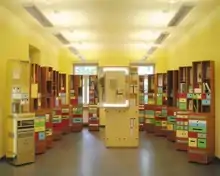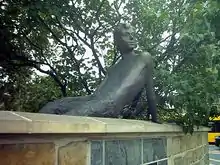Erich Kästner Museum
The Erich Kästner Museum is a literary museum in Dresden, Germany. The museum covers the life and writings of German children's author Erich Kästner and is based in the Villa Augustin building which had belonged to Kästner's uncle. The museum is notable for its architecture, which was designed to be semi-mobile and fit within a single room,[2]:28 close to where Kästner had grown up in Dresden's inner new town (Innere Neustadt).
 Movable display cabinets with drawers | |
 Location within Germany | |
Former name | Erich Kästner Centre |
|---|---|
| Location | Literaturhaus Villa Augustin, Albertplatz, Dresden, Germany |
| Coordinates | 51.0638°N 13.7457°E |
| Type | Literary museum |
| Visitors | 14,000[1] |
| Director | Andrea O'Brien |
| Architect | Ruairí O'Brien |
| Public transit access | Albertplatz tram stop |
| Website | www.erich-kaestner-museum.de |

The museum focuses on Kästner's early years in Dresden and Leipzig, the connections between his work and children, and his relationship to the media. The museum collection includes first editions by Kästner, including his most famous work Emil and the Detectives, along with garments and objects belonging to Kästner.
Museum
Established in 1999, the museum opened in early 2000 in celebration of the 101st anniversary of Kästner's birth[3] in the Villa Augustin at the Albertplatz in the Innere Neustadt (inner new town). The villa was formerly owned and inhabited by Erich Kästner's maternal uncle Franz Augustin, a horse trader, and Kästner regularly visited it as a youth. In his autobiographical novel When I was a little Boy (Als ich ein kleiner Junge war) he refers to the Villa and many places in the vicinity. The museum has a bronze sculpture by the Hungarian artist Mathyas Varga of one such remembered scene, Kästner as a boy perched on the wall, looking out into the bustling square and listening to the trams in Dresden.[3][4] In fact, Erich Kästner's childhood memories of Villa Augustin served him as an anchor point for inspiration; the main characters of the film Anna Louise and Anton (Pünktchen und Anton) are named after Kästner's cousin Dora Augustin, nicknamed "little dots" (Pünktchen), and the adjacent Anton-Street (Antonstraße, Dresden).
The museum was funded entirely by private donations,[5] organised by the Förderverein für das Erich Kästner Museum / Dresdner Literaturbüro.[6] The museum focuses on Kästner's years in Dresden and Leipzig, the connections between his work and children, and his relationship to the media.[5]
The Albertsplatz tram stops adjacent to the museum are announced by the Dresdner Verkehrsbetriebe (DVB) as "Albertplatz - Erich Kästner Museum".[7][8]
Architectural concept
The museum format was designed around the architectural concept that "less is more".[9] In his 1998 design, the Irish architect Ruairí O'Brien conceived of the museum as a "walkable treasure-chest" with core principles of mobility, interaction, and compactness, in other words a mobile, interactive micromuseum.[10] Installed on the ground floor, it takes up no more than a single 30-square-metre (320 sq ft) room, within which are thirteen mobile modules, each with drawers color-coded to signify an aspect of Erich Kästner's life and work. With the exception of original exhibits from Kästner's estate, visitors are encouraged to touch, read, and try out whatever they can find. In the center of the modules, the core element exhibits selected items from Kästner's estate.
The large tree in front of the museum became a shoe tree (Schuhbaum), with pairs of shoes being thrown over the branches of tree.[11][12] In 2018 the tree was cleaned of hanging shoes.[13]
Recognition
In 2002, the museum was awarded the Museum Prize from the Heinz and Brigitte Schirnig Foundation (Kulturstiftung-hbs) for its innovative open character and miniature scale.[14][15] In 2003 the "micromuseum" design concept of the museum received an award from the German Federal Culture Foundation.[16][7]
References
- Vanessa; Tri; Ella; Victor; Aurelius; Philip (11 March 2017). "Erich-Kästner-Museum mit Schüleraugen" [Erich Kästner Museum with pupils eyes]. Neustadt-Geflüster (in German). Retrieved 17 July 2019.
Ins Museum kommen jährlich ca. 14.000 Besucher unterschiedlichen Alters. … 70 Prozent sind aus dem Ausland und 30 Prozent aus Dresden.
- Mead, Andrew; Steiner, Petra (17 July 2003). "Memory matters". Architects' Journal (29): 26‒31. ISSN 0003-8466.
- Eisenschmid, Rainer; Reincke, Madeleine; Münch, Christoph (2013). Baedeker Reiseführer Dresden [Baedeker Travel Guide to Dresden] (in German). p. 243. ISBN 9783829791816.
- Eckhard Bahr, Dresden: mit Meißen, Radebeul und Sächsischer Schweiz, Berlin: Trescher, 2010, ISBN 9783897941564, p. 149 (in German)
- Erich Kästner Museum, Dresden, Citysam Dresden, retrieved 26 May 2014 (in German)
- "Wer wir sind" [Who we are] (in German). Literaturhaus Villa Augustin. Archived from the original on 28 May 2014. Retrieved 26 May 2014.
- Scally, Derek (21 February 2003). "Drawers of perception". The Irish Times. Retrieved 17 July 2019.
… run into huge official opposition. "The people from the museums authority told me that a Kästner museum would need at least three floors, …" … more than 25,000 visitors and is even announced on trams that stop around the corner, … official blessing came earlier this month, when the Federal Culture Foundation presented O'Brien with an award for his micromuseum concept.
- Schulz, Jörg; Püschel, Franziska (1 December 2017). ""Voll gruselig!" Dresdner genervt von Kindern in Straßenbahnen" ["Really creepy!", Dresdners annoyed by children's announcements in trams]. TAG24 (in German). Retrieved 17 July 2019.
"Nächste Haltestelle Albertplatz - Erich Kästner Museum" … Normalerweise werden die DVB-Fahrgäste von den Sprechern Conny Grotzsch und Hans-Dieter Leinhos über die nächste Haltestelle informiert.
- "Museum Recalls 'Parent Trap' Creator". Deutsche Welle. 25 February 2003.
O'Brien designed the unique tailor-made micro museum for Kästner … Following the maxim "less is more," … paying tribute to Kästner in the smallest possible amount of space, he created an "accessible treasure trove."
- "Erich Kästner Museum" (in German). City of Dresden. Archived from the original on 22 February 2014. Retrieved 26 May 2014.
- Giesecke, Una (26 December 2017). "Der Dresdner Baum der Wünsche" [Dresden's Wishing Tree]. Dresdner Wochenzeitung (in German). Retrieved 17 July 2019.
- Rahrisch, Sandro (6 February 2018). "Was machen diese Schuhe auf dem Baum?" [What are these shoes doing on the tree?]. Sächsische Zeitung. Retrieved 17 July 2019.
Die Dresdner Abfallwirtschaft kennt den Schuhirrsinn gegenüber dem Erich-Kästner-Museum schon
- Launer, Anton (19 April 2018). "Schuhbaum gesäubert" [Cleaned shoe tree]. Neustadt-Geflüster (in German).
Heute früh haben Baumpfleger den Baum am Albertplatz vorm Erich-Kästner-Museum von Schuhen befreit. … Die abrechenden Äste und gegebenenfalls herumfliegende Schuhe könnten Personen und Sachwerte erheblich gefährden, so die Stellungnahme der Stadtverwaltung.
- Oexle, Judith (26 October 2002). "Laudatio zum Preis Dresden" [Laudatio for prize at Dresden] (in German). Kulturstiftung-hbs. Retrieved 27 May 2014.
- "Harzer Weltkulturerbe erhält Museumspreis" [Harz World Heritage receives Museum Prize]. Braunschweiger Zeitung (in German). 25 October 2018. Retrieved 17 July 2019.
Zu den bisherigen Preisträgern zählten … und dem Erich Kästner Museum in Dresden.
- Brown, Louise (7 February 2003). "Looking Beyond the Facade". Deutsche Welle.
"micromuseums": … one of which is the Erich Kästner Museum in Dresden … can pull out various drawers which hold the exhibits. … architect will receive a prize from the Federal Culture Foundation on Wednesday